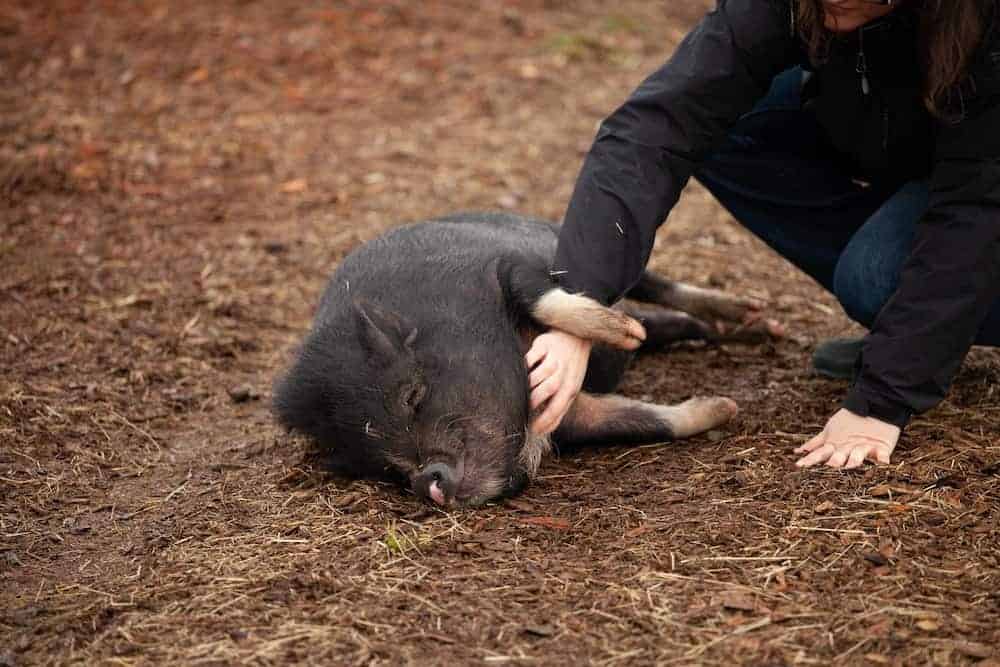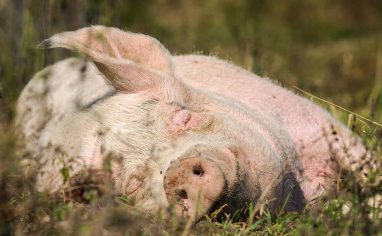
This resource has been fully reviewed and updatedA member of The Open Sanctuary Project’s staff has given this resource a full review and provided updates where necessary. by a member of The Open Sanctuary Project as of April 4, 2025. It was originally published on July 30, 2018.
Although you may have nothing but the best intentions and warmest feelings for them, just like humans, there are times when pigs might not want you in their personal space. While some residents may always prefer to keep their distance and new residents may be wary of you at first, even the most docile pig resident who typically loves hanging out with you may need some space sometimes! To ensure your own safety and the safety and well-being of your residents, it’s critical to recognize when a resident is telling you they need space or do not like something you are doing. Failing to do so could cause unnecessary stress for residents, not to mention potentially putting you or other caregivers in a dangerous situation.
Ask An Expert
If you are not used to being around pigs and are bringing a pig resident into your sanctuary, you should have an expert give you hands-on training regarding how to safely be around pigs and how to recognize important vocal and physical cues.
Always Use Caution Around Unfamiliar Pigs
If you do not personally know an individual pig, do not assume you know how they will react to your presence. It’s important to spend time observing the individual and to pay close attention to how they react to your presence in their space. Whenever possible, avoid being in a confined space with the individual until you have a better idea of how they will respond to your presence and whatever activities you may need to engage in. Pig boards (also called sorting panels or sorting boards) can be a useful tool when working with individuals who are fearful or confrontationalBehaviors such as chasing, cornering, biting, kicking, problematic mounting, or otherwise engaging in consistent behavior that may cause mental or physical discomfort or injury to another individual, or using these behaviors to block an individual's access to resources such as food, water, shade, shelter, or other residents. (or whose reaction to human presence is still unknown) because they can act as a protective barrier between a caregiverSomeone who provides daily care, specifically for animal residents at an animal sanctuary, shelter, or rescue. and a pig resident.
Signs A Pig Wants To Be Left Alone
To safely work around pigs and best meet their needs, it’s important to be able to recognize signs of fear and stress so that you can take steps to alleviate these feelings and also so you can avoid putting yourself in a potentially dangerous situation. A pig who is stressed or scared is more likely to respond in a way that could cause injury to their caregivers, and therefore it’s important to either give the individual space to calm down, or if that is not possible, to take steps to protect yourself (such as by keeping a pig board between you and the individual).
Signs a pig may be feeling fearful, stressed, or agitated include:
- Tensing their body
- Raising their hackles
- A long, low grunt
- Screaming (pigs will also loudly vocalize when anticipating a meal)
- Chomping their mouth (may be accompanied by foaming, but please note that it is also common for pigs to also foam at the mouth in anticipation of a meal)
- Flicking their tail
- Quickly swinging their head to the side (this is particularly dangerous if the individual has sharp tusks)
- Positioning themselves so their side is facing you
- Lowering their head and looking up at you
- Circling you
By recognizing these cues, you can take appropriate steps to diffuse the situation and/or to protect yourself. Be aware that a very agitated pig may charge at you, so you must be prepared to move and should have a plan in place if you need to quickly exit the space the pig is in. If you are not able to and do not have pig boards to help protect you, find a way to put something between you and the individual, be it a tree, a wagon, or even other pig residents. If at all possible, don’t turn your back and run away from an agitated pig unless you are in immediate danger and need the extra speed.
Understanding Things That Make A Pig Uncomfortable
While our goal should be to avoid situations and activities that could make a resident uncomfortable, as much as possible, there will inevitably be times when you simply can’t. However, understanding some of the things that could make a pig resident uncomfortable can help you make more thoughtful choices about how you interact with them. Below we’ll discuss some of their instincts and how they may react to a disruption:
Daily Habits
Pigs find a lot of comfort in daily routines and can become annoyed or afraid if their routine is disrupted, so be extra gentle and allow extra time if you’re asking your pig residents to do something they aren’t used to doing, like going to a new pasture or barn. You should also anticipate quite a bit of displeasure if you disrupt or delay their meals!
Flight Zone
Like most herd animals, pigs have a flight zone. This is the imaginary space around an individual that is essentially their personal space. Entering this space will make the individual feel uncomfortable or even threatened, depending on the circumstance. The size of an individual’s flight will vary based on things like their comfort level around humans, past experiences, and personality. It can also change in size depending on their surroundings, the situation, and how they are being approached. Entering a resident’s flight zone will cause them to feel threatened, and they will likely walk away from you. If you go much more into their flight zone or move into their flight zone quickly, they might bolt or display signs of fear or agitation described above.
Don’t Get Cornered
If you are cornered or in a tight space with a frightened pig, there’s a chance that they could push you into a wall or a gate to escape the situation. Depending on the size of the individual (and whether or not they have sharp tusks), this could lead to serious injury, so it’s crucial that you always have an appropriate escape route and take your time approaching the individual to gauge how they’re going to react as you get nearer!
Hearing
Pigs are very sensitive to high-pitched and loud noises, which are typically used as alarms among themselves. Being yelled at, hearing barking dogs, or encountering loud noises can spook, agitate, and trigger flight and charge responses in wary pigs. Try to be very cautious with volume around pig residents and keep talkative dogs away from them to prevent incidents. It’s also important to note that loud vocalizations from other pigs could cause residents distress. Of particular note, if you must restrain a pig resident for a medical procedure, they will very likely vocalize in protest, which could put the rest of your pig residents on edge. For this reason, we always recommend taking steps to restrain a resident in a space that is physically separate from other pigs so you do not find yourself surrounded by agitated pigs. Failing to do so could prove dangerous for caregivers.
Isolation
Pigs are social animals who enjoy spending time with their pig friends and sleeping in communal nests. Wild and feral pigs live in small matriarchal groups called sounders. These groups typically consist of 1-6 females and their offspring. Wild and feral male pigs tend to be more solitary, but in sanctuary settings where residents are routinely neutered and spayed, both males and females commonly form strong bonds with other pig residents. To honor their social needs and promote well-being, we recommend avoiding forcing a pig resident to live alone, as this can lead to depression, boredom, and unease, which could lead to behavior challenges. However, there may be times when you need to temporarily single out or separate a pig resident, and this must be done carefully and calmly.
Hunger
Pigs, especially large breed pigs, have famously voracious appetites. If it’s near mealtime and they haven’t gotten their regularly scheduled food yet, they may be more prone to exhibiting signs of discomfort or agitation than usual! As mentioned above, loudly vocalizing in anticipation of a meal (or to protest a delayed meal) is common.
Illness Or Discomfort
If a pig resident has fallen ill or is generally uncomfortable, they may be more irritable than usual. If not already done, it’s important to conduct a health check and/or work with your veterinarian to determine the cause of their discomfort. Please note that a pig resident will also be uncomfortable if they become too warm, and they may be less amenable to human interaction during this time. Warm temperatures are not only uncomfortable for pig residents but can also be dangerous, putting them at risk of heat stress and heat-related illness, so steps must be taken to keep them from overheating, and handling should be avoided as much as possible.
Maternal Instincts
If you’re caring for a mother pig with piglets, it’s important to know that mother pigs tend to be very protective of their piglets, which could manifest as more confrontational behaviors toward humans. While some mothers may become agitated just by the presence of a human near their babies, others may only become agitated if one of their babies screams (which a healthy piglet will typically do when handled or restrained). A screaming piglet can quickly result in an agitated and fast-moving mother, which can not only pose a safety risk to humans but can also put piglets at risk of being accidentally stepped on.
Those working with a pig family should be well-versed in pig body language and vocalizations so that they can watch for signs that the mother or babies are becoming stressed. While you should not force a mother pig to live separately from her babies unless absolutely necessary for their health, you may find that very brief separation is necessary to safely evaluate a piglet or perform certain health care procedures without agitating the mother. You can read more about creating living spaces for mother pigs and their babies, as well as tips for safely working around them, in our piglet care resource. While the focus of this resource is young piglets, remember that just because a piglet has grown into a large adolescent or adult, it doesn’t necessarily mean their mother will cease being protective!
Sight
Although they have excellent senses of hearing and smell, pigs have poor vision, especially directly in front of them and have limited ability to focus on subjects compared to humans. Therefore, if a pig is relying upon vision to see you or explore an area they haven’t been in before, they may be more hesitant and uncomfortable than usual. Give them extra time and a gentle touch if you need to bring them into a new space!
Surprise
When a pig is startled, especially by a human they did not realize was approaching them, their initial reaction may be fear or agitation. Always give them ample heads up when entering their space to avoid startling anyone!
Tips For Safely Handling A Pig
Because of the importance of regular health assessments, it’s critical to ensure that you and your veterinarian can safely handle each of your pig residents. If they aren’t averse to humans due to past trauma with humans, generally, you can help accustom pig residents to your touch by running your hands gently over their bodies and legs when they’re relaxed, or by giving them belly rubs if they like! Another popular practice, particularly with mini pigsThe term “mini pig” is used to categorize smaller breeds of pigs, such as Potbellies, Julianas, and Kunekunes, and to differentiate between these breeds and large breed pigs, such as Yorkshires, Landrace, or Hampshires, who are sometimes referred to as “farm pigs”. The descriptor “mini” can be a bit misleading- some breeds of mini pigs can weigh over 200 pounds! Terms like “teacup”, “micro”, “pocket”, “nano”, and “micro mini” are deceptive terms that are sometimes used to intentionally mislead people into thinking an individual pig will remain a certain size., is “forking,” where you use a fork, or a similarly pointy but not dangerous instrument, to gently poke and scratch the individual. Some pigs will flop over the second they are touched with the fork or the second they anticipate a belly rub, and this can make certain care tasks much easier and less stressful! We recommend spending time getting pig residents accustomed to belly rubs or forking well before you need to perform a health checkThe Open Sanctuary Project uses the term "health check" to describe health evaluations performed by caregivers who are not licensed veterinarians. While regular health checks are an important part of animal care, they are not meant to be a replacement for a physical exam performed by a licensed veterinarian. or other task that requires their cooperation.
Some pig residents may never be fully comfortable with humans and may need to be gently restrained or medicated (under veterinary guidance) before you can safely perform certain care tasks. Even for those residents who typically do enjoy a belly rub, there may be times when they are less amenable to them or when a care task requires a different strategy to help keep them still. Restraint options for mini pigs typically include sitting the individual on their bum, placing them on their back, or using a sling. Restraint for large breedDomesticated animal breeds that have been selectively bred by humans to grow as large as possible, as quickly as possible, to the detriment of their health. pigs can be more challenging. Some sanctuaries have invested in a chute designed specifically for large breed pigs, and other sanctuaries have attempted to make their own. While you may come across folks who recommend the use of a wire snare, this is an unacceptable method of restraint that can cause pain and injury. As an alternative, some sanctuaries have opted to use a soft rope snare for restraint as needed, but other sanctuaries are strongly against this practice. Depending on the task at hand, brief restraint may be easily achieved by using pig boards to guide the individual into a corner or other tight spot and then using the boards to keep them contained there.
What Does ‘Unacceptable’ Mean?
At The Open Sanctuary Project, unacceptable means that we cannot condone (or condone through omission) a certain practice, standard, or policy. See a more detailed explanation here.
SOURCES:
General Overview Of Pig Behavior | Minipig Info
Aggressive [Mini] Pigs | Minipig Info
General Behavior Of Pigs In Captivity | California Potbellied Pig Association








